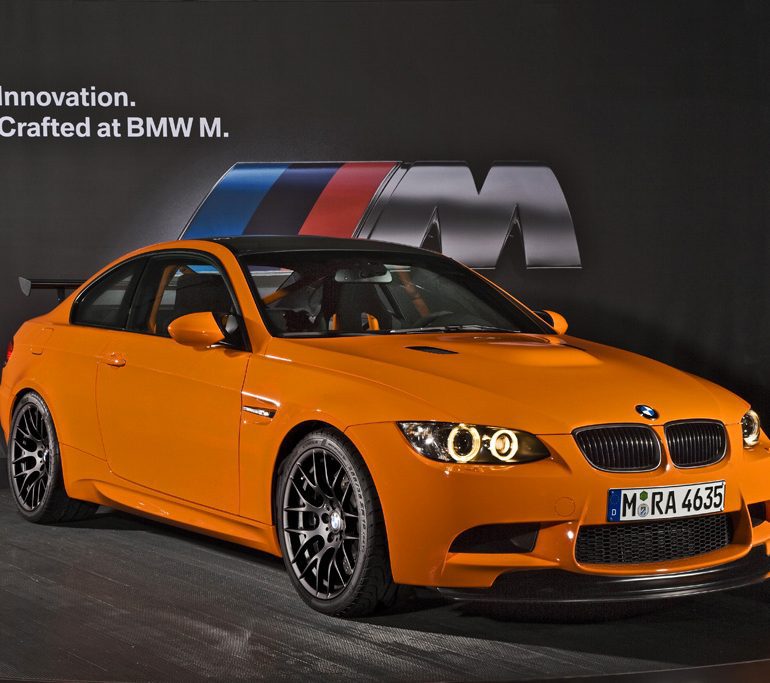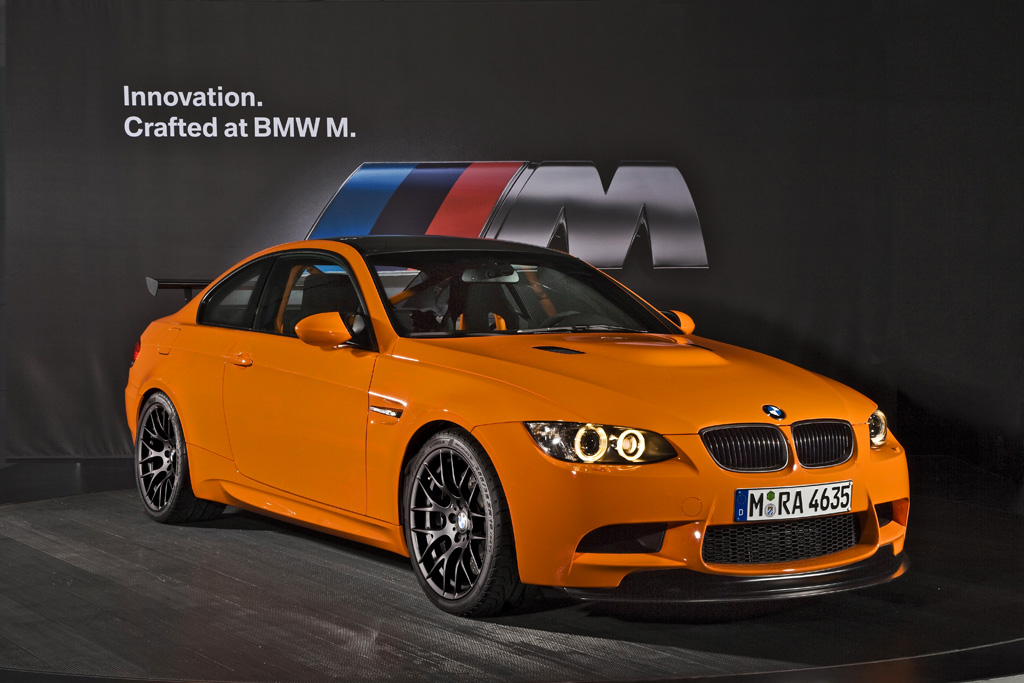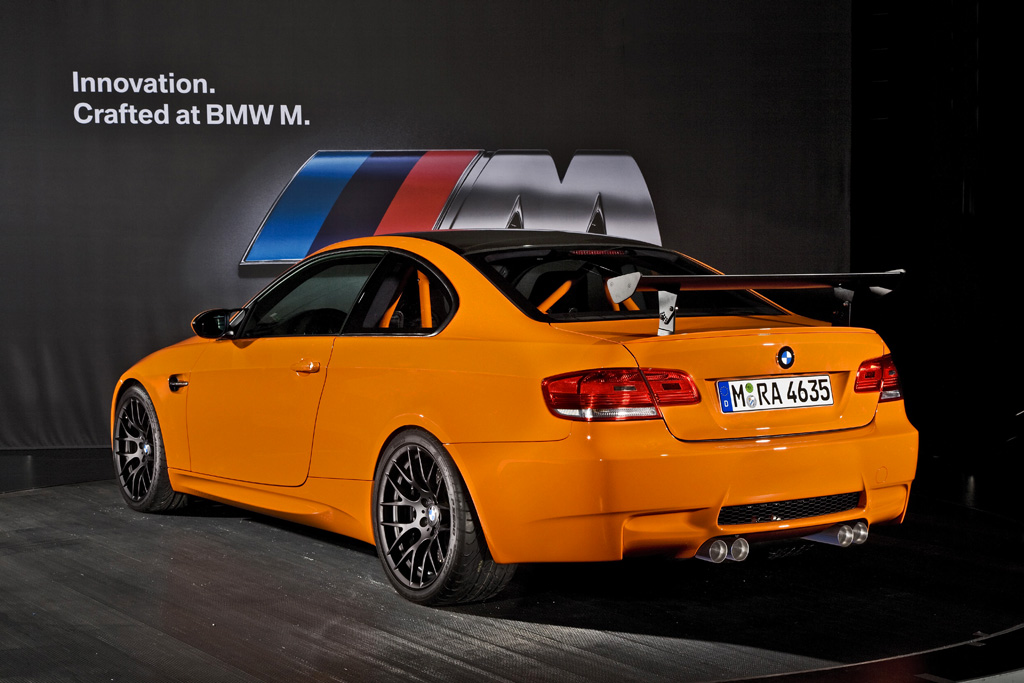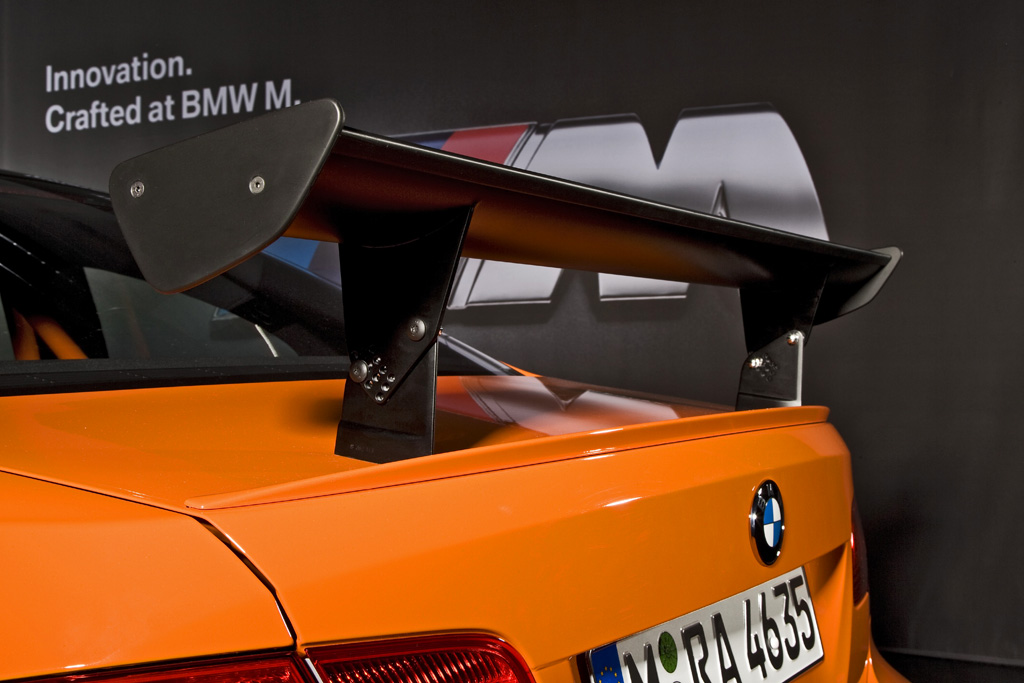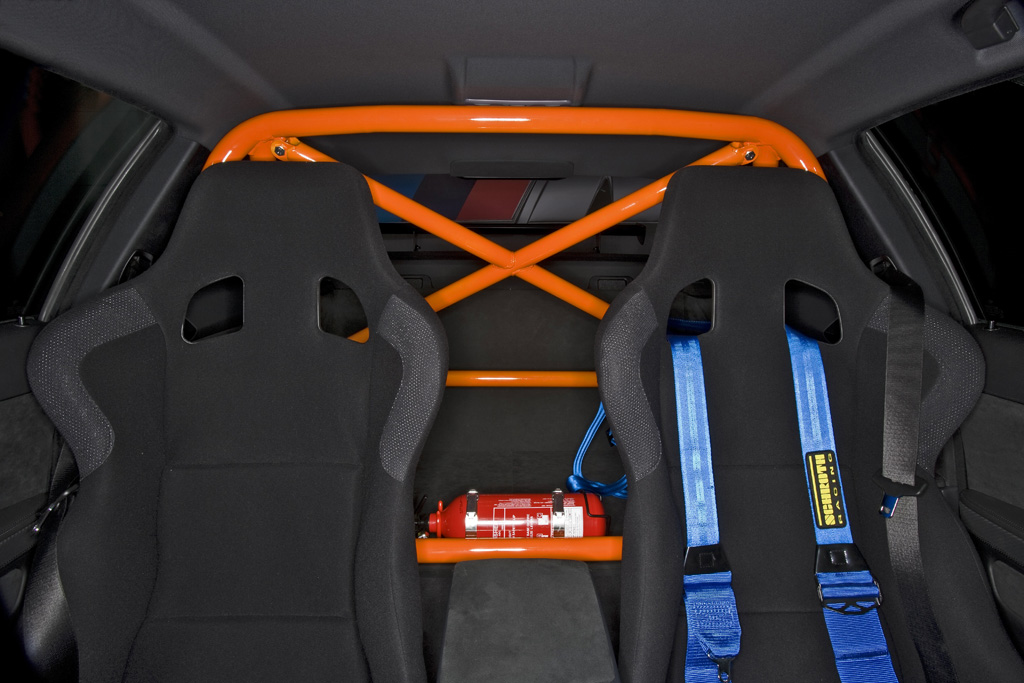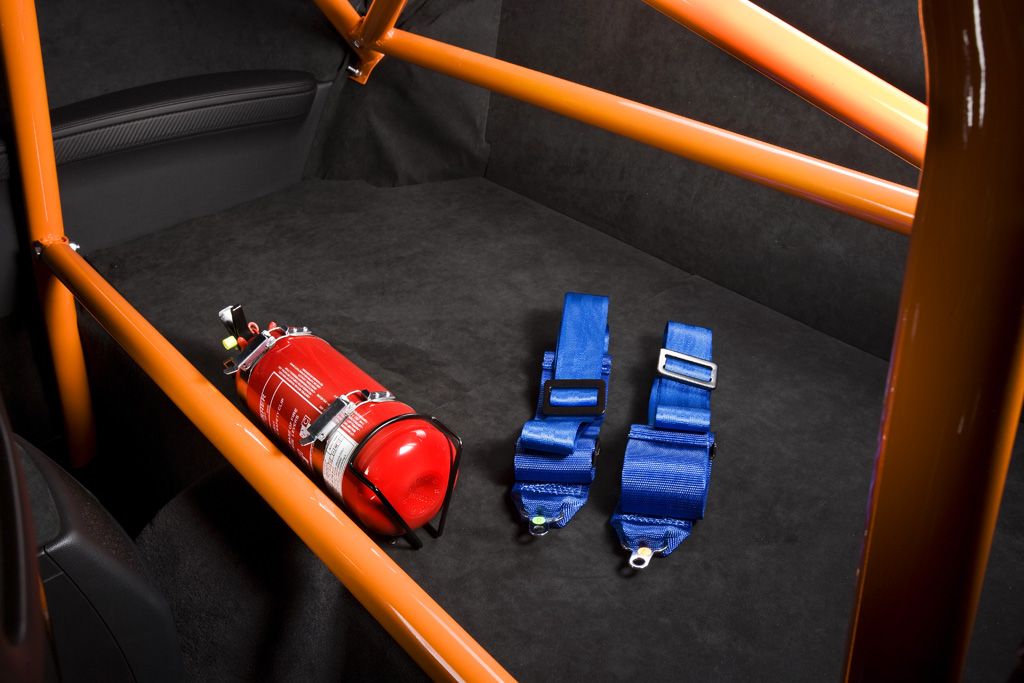2010 BMW M3 GTS
The history of BMW M3 motor sport has been enriched by a further fascinating chapter as the BMW M3 GTS celebrates its debut on the racetrack and on the road. In terms of performance and safety, the most powerful version of the high-performance BMW M3 Coupe featuring a 331 kW/450 bhp engine offers the ideal preconditions for use at club sport events, whilst at the same time being officially road-legal. The BMW M3 GTS is produced at the BMW M GmbH manufacturing facility. In addition to a larger and more powerful V8 engine, exclusive tuning of the 7-speed M Dual Clutch Transmission with Drivelogic and modified suspension technology, the car, which is designed for club sport use, has also been specifically optimised with regard to aerodynamics and lightweight construction.
The supreme sporting potential of the BMW M3 GTS is underlined, inter alia, by a power-to-weight ratio that has been lowered to 3.4 kg per hp. Featuring a transmission and suspension configuration which has been optimised for the racetrack, the BMW M3 GTS accelerates from 0 to 100 km/h in a mere 4.4 seconds. The car reaches the 1000 metre mark from a standstill in just 22.5 seconds. Top speed is 305 km/h.
“The BMW M3 is an icon and internationally synonymous with the highest level of dynamics,” explains Dr. Kay Segler, CEO of the BMW M GmbH. “Our aim was to develop a model variant that would prove its outstanding potential both on the road and at club sport racing events. The BMW M3 GTS is pure M feeling, embodying the brand values in a highly concentrated form.”
BMW M3 in motor sports.
For as long as two decades and four model generations, the BMW M3 has been the embodiment of spectacular motor sports successes. The number of victories and titles achieved in touring car sports has never been matched by any other model. With its precisely balanced overall concept, the latest BMW M3 also provides the ideal basis for outstanding performance on the racetrack. The BMW M3 GT2 is currently causing quite a stir at long-distance motor sports events. The BMW M3 is also playing a predominant role in preparing the brand’s comeback at the “German Touring Car Masters”. Parallel to this, BMW is currently setting new standards in the support of club motor sports. The many decades of experience in the development of racing cars and high-performance, road-going automobiles are reflected in the high performance potential of the BMW M3 GTS.
High-revving V8 engine
The power required for high performance in motor sports is delivered by an
8-cylinder engine featuring a high-revving concept. With its unparalleled enormous pulling force, which is constantly available over a very wide engine speed range, the V8 engine developed exclusively for the BMW M3 by the BMW M GmbH features refined performance characteristics that are closely oriented towards the requirements of motor sports. A version of this power unit with further increased displacement, power output and maximum torque was exclusively conceived for the BMW M3 GTS.
The increase in displacement from 3,999 to 4,361 cc is achieved by a cylinder stroke that has been extended from 75,2 to 82 mm. In the enlarged combustion chamber, a maximum power output of 331 kW/450 bhp (BMW M3: 309 kW/420 bhp) is delivered at 8,300 rpm. Maximum torque has been increased by 40 Nm to 440 Nm and is available at an engine speed of 3,750 rpm.
Characteristic constructional features derived from motor sports, which include, inter alia, the crankcase designed as a bedplate construction and made of a special aluminium-silicon alloy, individual throttles, knock sensors featuring ionic-current technology and a dynamically optimised wet-sump oil supply have been adopted from the original power unit. The lightweight sports exhaust system developed for the BMW M3 GTS with model-specific primary catalytic converters and titanium rear silencers ensure optimum exhaust flow.
Transmission of power is effected by means of the M Dual Clutch Drivelogic gearbox developed for the BMW M3. This 7-speed transmission operates according to a principle also developed for motor sports and permits gear shifting without interruption of traction for extremely dynamic acceleration. Its gear shift characteristics have been exclusively tuned to the modified engine featured by the BMW M3 GTS.
High-performance suspension
The car’s suspension technology also derived from motor racing is based on the front and rear axle construction featured by the BMW M3 Coupe. Contrary to that, the BMW M3 GTS features a rigid rear-axle support as well as a coilover suspension, the dampers of which are independently variable in the traction and compression travel. Moreover, camber on the front and rear axles and vehicle height are variable for motor racing purposes. The car is lowered by 16 mm at the front and 12 mm at the rear.
The high-performance brake system featured on the BMW M3 GTS has been designed as a fixed-calliper construction and comprises six pistons on each of the front wheels and four pistons on each rear wheel. Compared to the BMW M3, the brake discs are 18 mm larger in diameter at the front and 30 mm larger in diameter at the rear. Furthermore, steel-armoured hoses are used.
Specific tuning of the stability control function DSC (Dynamic Stability Control), including ABS and the M Dynamic Mode (MDM), make allowances for the increased dynamic potential of the BMW M3 GTS. Optimum transfer not only of acceleration torque but also of the brake torque is also guaranteed by mixed tyres on matt black, 19-inch M light alloy wheels featuring a Y-spoke design.
Aerodynamics
In order to optimise air stream and for on-demand adaptation of downforce characteristics, the BMW M3 GTS is fitted with motor racing-oriented front apron and rear wing elements. They offer the possibility to adapt the car’s aerodynamic characteristics according to the racetrack profile and other basic club motor sport requirements. The air duct elements in the front apron are also variable, as is the position of the rear wing. The tail assembly is based on the corresponding component featured by the BMW 320si in the World Touring Car Championship (WTCC).
The BMW M3 GTS can be recognised from the outside by its bright orange single-coloured body. Additional model-specific features are the matt black exterior components such as the BMW kidney grille, roof trims and alloy wheels as well as the side gill elements made of dark anodised chrome. In addition to the standard CFRP roof on the BMW M3 and titanium rear silencers, an exceptionally light construction of the centre console and door panels, the use of polycarbonate side windows at the rear and a polycarbonate rear window, dispensing with seats in the rear compartment and acoustic insulation configured specifically for the vehicle all serve to guarantee weight optimisation. The unloaded weight of the BMW M3 GTS according to DIN is 1,530 kg including roll bar and M Dual Clutch Drivelogic transmission (BMW M3: 1,600 kg). Automatic climate control and audio system supplied as standard comfort features in the BMW M3 can be fitted if the customer desires.
The interior of the BMW M3 GTS reflects a predominant focus on optimum performance and the highest level of safety on the racetrack. The range of equipment includes thoroughbred racing bucket sets, carbon interior trims and an Alcantara® M steering wheel. Door and sidewall linings in the rear compartment are also made of Alcantara®. The BMW M3 GTS is equipped as standard with a roll bar fitted behind the B-pillars. Furthermore, the car body offers fastening points for six-point safety seat belts and an optional extension for the roll cage. The car is fitted with three-point automatic seatbelts for road use. Additionally supplied six-point safety seat belts for driver and front seat passenger and a fire extinguisher complete the range of equipment.
2010 BMW M3 GTS Gallery
See full 2010 BMW M3 GTS Gallery here
In Detail
| submitted by | anonymous |
| type | Series Production Car |
| built at | Garching, Germany |
| price $ | $ 170,000 |
| price €/td> | €136,850 |
| engine | V8 |
| position | Front Longitudinal |
| aspiration | Natural |
| block material | Aluminum/Silicon Alloy |
| valvetrain | DOHC, 4 Valves per Cyl w/double-VANOS |
| fuel feed | Electronic Fuel injection |
| displacement | 4361 cc / 266.12 in³ |
| bore | 92 mm / 3.62 in |
| stroke | 82 mm / 3.2 in |
| compression | 12.0:1 |
| power | 335.6 kw / 450 bhp @ 8300 rpm |
| specific output | 103.19 bhp per litre |
| bhp/weight | 294.12 bhp per tonne |
| torque | 440 nm / 324.5 ft lbs @ 3750 rpm |
| redline | 8400 |
| body / frame | E92 Unitary Steel Monocoque |
| driven wheels | RWD w/M Differential Lock |
| wheel type | 19-inch M light alloy |
| front brakes | Discs w/6-Piston Fixed Calipers |
| rear brakes | Discs w/4-Piston Fixed Calipers |
| f suspension | MacPherson Struts w/Strut Tiebar |
| r suspension | Five-Arm Multi-Link |
| curb weight | 1530 kg / 3374 lbs |
| transmission | 7-Speed Automatic |
| tran clutch | Dual Clutch |
| top speed | ~304.10 kph / 189 mph |
| 0 – 60 mph | ~4.4 seconds |


